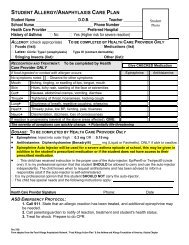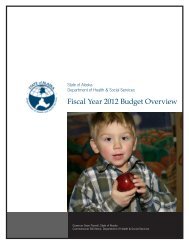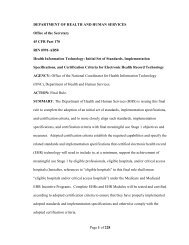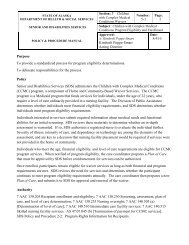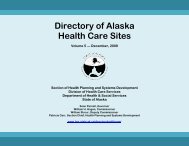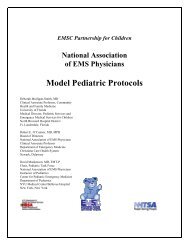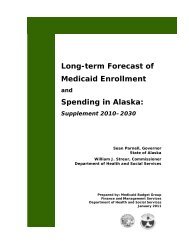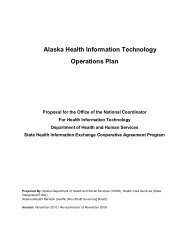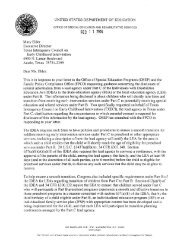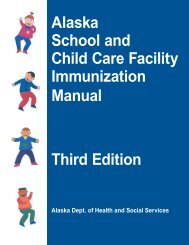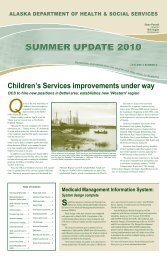Long-term Forecast of Medicaid Enrollment Spending in Alaska:
Long-term Forecast of Medicaid Enrollment Spending in Alaska:
Long-term Forecast of Medicaid Enrollment Spending in Alaska:
You also want an ePaper? Increase the reach of your titles
YUMPU automatically turns print PDFs into web optimized ePapers that Google loves.
Total <strong>Medicaid</strong> Claims <strong>Spend<strong>in</strong>g</strong><br />
Figure 13: Inflation accounts for the largest part <strong>of</strong> <strong>in</strong>creased claims<br />
spend<strong>in</strong>g<br />
SPENDING DECOMPOSED INTO GROWTH COMPONENTS<br />
Millions<br />
$3,500<br />
Total service spend<strong>in</strong>g<br />
$3,000<br />
$2,500<br />
$2,000<br />
$1,500<br />
$1,000<br />
$500<br />
$0<br />
Status Quo Population Growth <strong>in</strong> Services Inflation<br />
Source: <strong>Medicaid</strong> Budget Group, MESA model<br />
Figure 13 shows the growth <strong>in</strong> total spend<strong>in</strong>g by components that affect<br />
spend<strong>in</strong>g growth. The components <strong>of</strong> spend<strong>in</strong>g growth are as follows:<br />
Status Quo refers to what would happen if there were no growth <strong>in</strong> health<br />
cost <strong>in</strong>flation, no growth <strong>in</strong> population, and no growth <strong>in</strong> the use and<br />
<strong>in</strong>tensity <strong>of</strong> services provided. The status quo assumes that everyth<strong>in</strong>g <strong>in</strong><br />
future years rema<strong>in</strong>s exactly the same as <strong>in</strong> 2009.<br />
Population Growth is the additional cost on top <strong>of</strong> the status quo result<strong>in</strong>g<br />
from population growth. Only the <strong>in</strong>crease <strong>in</strong> total population is taken <strong>in</strong>to<br />
account and not demographic changes such as an ag<strong>in</strong>g population.<br />
Growth <strong>in</strong> Services <strong>in</strong>cludes the additional spend<strong>in</strong>g associated with a greater<br />
use and <strong>in</strong>tensity <strong>of</strong> services provided. Growth <strong>in</strong> services is the result <strong>of</strong> an<br />
ag<strong>in</strong>g population and other demographic changes, as well as the change <strong>in</strong><br />
amount, duration, and scope <strong>of</strong> services provided from an <strong>in</strong>crease <strong>of</strong><br />
technology.<br />
Inflation is the rate at which the price <strong>of</strong> a given medical service is expected to<br />
<strong>in</strong>crease over time.<br />
The component that will have the largest <strong>in</strong>fluence on total spend<strong>in</strong>g is <strong>in</strong>flation.<br />
Without <strong>in</strong>flation, <strong>Medicaid</strong> claims spend<strong>in</strong>g would <strong>in</strong>crease from $1.1 billion to<br />
$1.6 billion <strong>in</strong> 2029, an average annual growth rate <strong>of</strong> 2.0 percent. Inflation,<br />
however, <strong>in</strong>creases the amount <strong>of</strong> spend<strong>in</strong>g <strong>in</strong> 2029 by an additional $1.8 billion<br />
for a total cost <strong>of</strong> $3.4 billion – a comb<strong>in</strong>ed annual <strong>in</strong>crease <strong>of</strong> 5.8 percent over the<br />
forecast period.<br />
<strong>Long</strong> Term <strong>Forecast</strong> <strong>of</strong> <strong>Medicaid</strong> <strong>Enrollment</strong> and <strong>Spend<strong>in</strong>g</strong> <strong>in</strong> <strong>Alaska</strong>: 2009‐2029<br />
17



